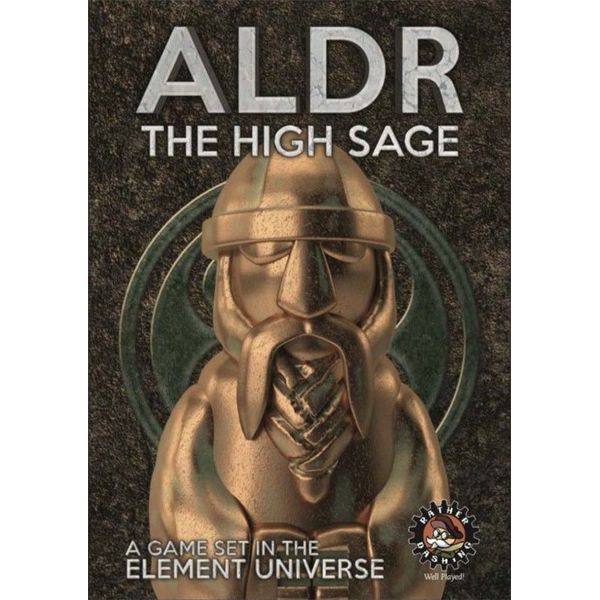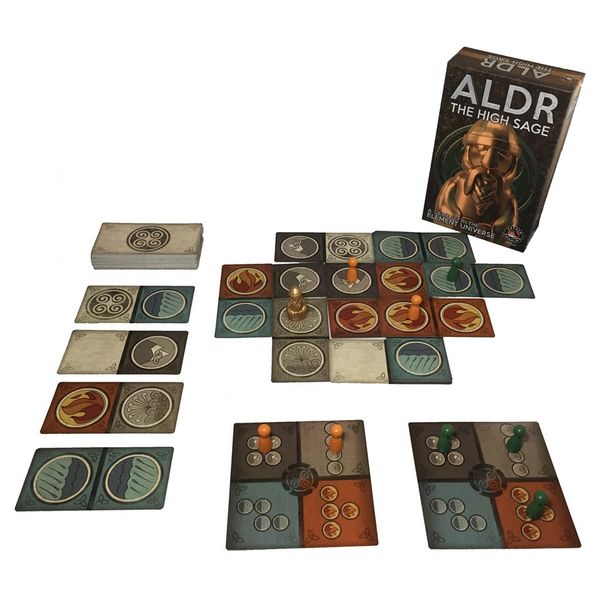Master the Elements and Form Patterns in Card Placement Strategy Game ALDR: The High Sage

ALDR: The High Sage has players competing to form four different patterns of elements, by playing cards onto the communal tableau. You must keep in mind which elements beat which if you hope to thwart your opponents and meet your goals.
Attractive, strategic, and easy to set up and play, ALDR: The High Sage is a pleasant abstract strategy game for 2-4 players that will take time to master.
Gameplay
Each player takes a tapestry card. These are all identical and show the patterns that each of the four elements require. It also shows which element beats which other single element (for example, earth beats water, while water beats fire). You place one of your pawns on each element on the card.
The deck of cards is shuffled and five cards are dealt to each player. Each card is divided in half, with each half showing a square of either an element, a void, or a wild. Four cards are then placed face up to form the draw pool and the deck is placed beside it. Finally the start tile, showing one square each of the four elements, is placed in the center of the table.
On your turn you play two cards to the tableau on the table. When adding a card, one of its squares must overlap with at least one other element square already on the table. An element can only be played on a matching element or onto the element that it beats, on a void square, or on a wild. Wilds represent any element, while voids simply are used to block players. Voids and wilds can be played on any square.
After you play your two cards, you check to see if you have created a pattern of element cards that match one shown on your tapestry card. If so, you take the relevant pawn and place it on any element square in the pattern (wilds do not count). Pawn placement is important —while an opponent can use some of the same squares you used to create his own pattern, he cannot use a square that includes a pawn (or the Aldr figurine), nor can any cards be placed to cover a square with a pawn or Aldr.
Next you move the Aldr figurine to any element square (it cannot be a void or a wild). You then choose two new cards from the draw pool, replacing each card as you go, and your turn ends. The first player to complete all four element patterns wins the game.

Review
ALDR: The High Sage is an abstract card placement and pattern-building game, with an extra element (pun intended) that adds another dimension to the gameplay and the puzzle you have to solve. You need to figure out how to create each element’s pattern in the card tableau, without setting up your opponents to do the same or allowing them to beat you to it. The fact that when laying cards, you not only can place an element on top of a matching element but can also place it on top of the element that it beats, makes this more difficult to accomplish.
There’s plenty of player interaction, from moving Aldr to where you place your pawns after completing an element. You want to keep an eye on what cards your opponents draft so that you can plan your own moves accordingly and know where to most effectively block them.
The game’s components are quite high quality. Aldr is a solid, golden piece and the pawns, while plain, are attractive. The cards are large and sturdy as well, though given their oversized and unusual shape, they are a little difficult to shuffle. The size of the components also means you want a good bit of table space for playing.
Strategic, easy to teach, but with a pleasant learning curve for mastering the game, ALDR: The High Sage has plenty to offer for abstract fans. As a bonus, if you enjoy Element from Rather Dashing Games, ALDR: The High Sage also includes a mini-expansion for it.
Pros: Excellent component quality, plenty of player interaction, the element system works well with card placement
Cons: Needs a good amount of table space, cards are hard to shuffle
Disclosure: we received a complimentary review copy of this game.







